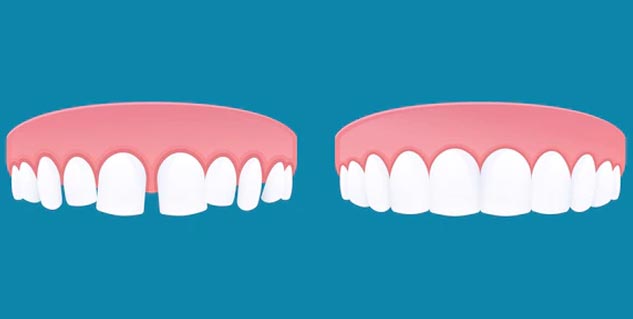
Smiles with white teeth evenly spaced and aligned on the dental arch are beautiful to look at. Smiles like those give people more confidence and can contribute to success in personal and professional lives of individuals. But what if you get gap between teeth? This looks unpleasant and also cause a lot of trouble while eating. Dr. Kundabala Mala, Professor,Department of Conservative Dentistry and Endodontics, Manipal College of Dental Sciences, Mangalore, Manipal Academy of Higher Education, Manipal explains diastema meaning, its causes and how this can be treated.
Table of Content:-
Diastema- Gap Between Teeth
Diastema refers to teeth with unusual presence of gaps between teeth, especially in the anterior part of the dental arch. It is one of the most common problems encountered in clinical dentistry. Diastema can be diagnosed when a patient has a gap greater than 0.5 mm between the proximal surfaces of the two central incisors. These gaps create esthetic problems and phonetic problems if they exist in the anterior region. When diastema exists in the posterior region of the oral cavity, it may contribute to the faster progress of gingival disease due to food impaction between teeth.
What Causes Gaps Between Teeth?
Various factors that can lead to gaps between your teeth are:

- Normal growth - A gap between the front teeth is completely normal most of the time. Diastema is commonly present in children aged 6 to 8, and it usually closes as they grow older.
- Periodontitis (Gum Diseases) - Gum diseases refer to infections of your gums that damage the tissue and bone that support your teeth. This further causes gaps between teeth. Symptoms of gum infections include swollen gums, bleeding, pain while chewing, loose teeth, and abnormal coloured teeth.
- Abnormal size, shape, and position of your teeth - Some people’s teeth are of unusual size, shape, or position with spaces between them. If your teeth are not in a normal position, it can cause teeth to drift apart, leading to gaps between teeth.
- Extra teeth in your mouth - Gaps between teeth are often formed if the extra teeth or baby teeth have not fallen out. Another cause of gaps can be cysts and large frenum.
- Bad habits - Bad habits such as biting your lower lip, sucking on your finger, or anything that puts pressure on your front teeth can lead to gaps between teeth. A gap between the teeth can also be due to someone placing their tongue piercing between their upper front teeth, causing a diastema to form. Pressing your tongue too hard can cause diastema in the lower front teeth.
Diastema Treatment
Treatment for diastema widely varies depending on its underlying cause. Most people consider diastema a cosmetic issue until and unless it causes a severe problem like gum disease. Some common treatments for diastema include;

Braces
Braces are wires and brackets that exert pressure on teeth for them to move together into their usual position. They are the most common treatment for diastema. In recent times, invisible or removable braces have gained popularity. Veneers are also another option to fill gaps to improve the teeth.
Surgery
In severe diastema cases, doctors may recommend surgery before orthodontic treatment, especially if the condition is due to a large or low frenum or a cyst. Surgery does not guarantee that the gap will close, and other treatments may be required to treat diastema completely.
Antibiotics
Some less invasive treatments include antibiotics. This can be in the form of mouth rinses or gels. Scaling also helps remove bacteria from your teeth and your gums. In cases of children, the gap often closes on its own as they grow older. It is recommended to consult a dentist and get your teeth evaluated.

Prevention
While there are various treatments available for treating diastema, it is recommended to reduce the risk of developing a gap in the first place. Some ways to prevent diastema include:
- Stop your child from sucking on their thumbs.
- Brush your teeth twice a day, and floss regularly to prevent gum disease.
- Visit your dentist twice a year for regular cleanings as it is impossible to remove all the plaque even if you brush and floss regularly.
It is okay to have gap in between teeth unless it is not causing you any trouble. If it is, consult a dentist to look for possible treatment options as per the cause.
Image credits- freepik
Also watch this video
How we keep this article up to date:
We work with experts and keep a close eye on the latest in health and wellness. Whenever there is a new research or helpful information, we update our articles with accurate and useful advice.
Current Version